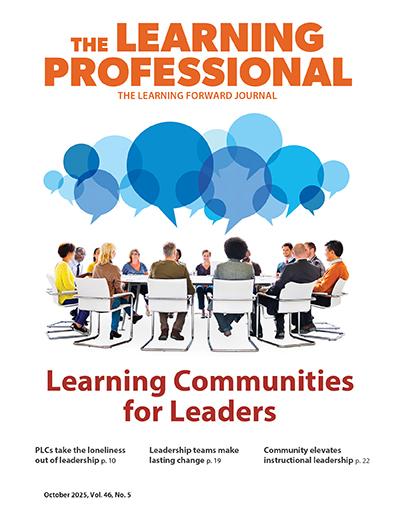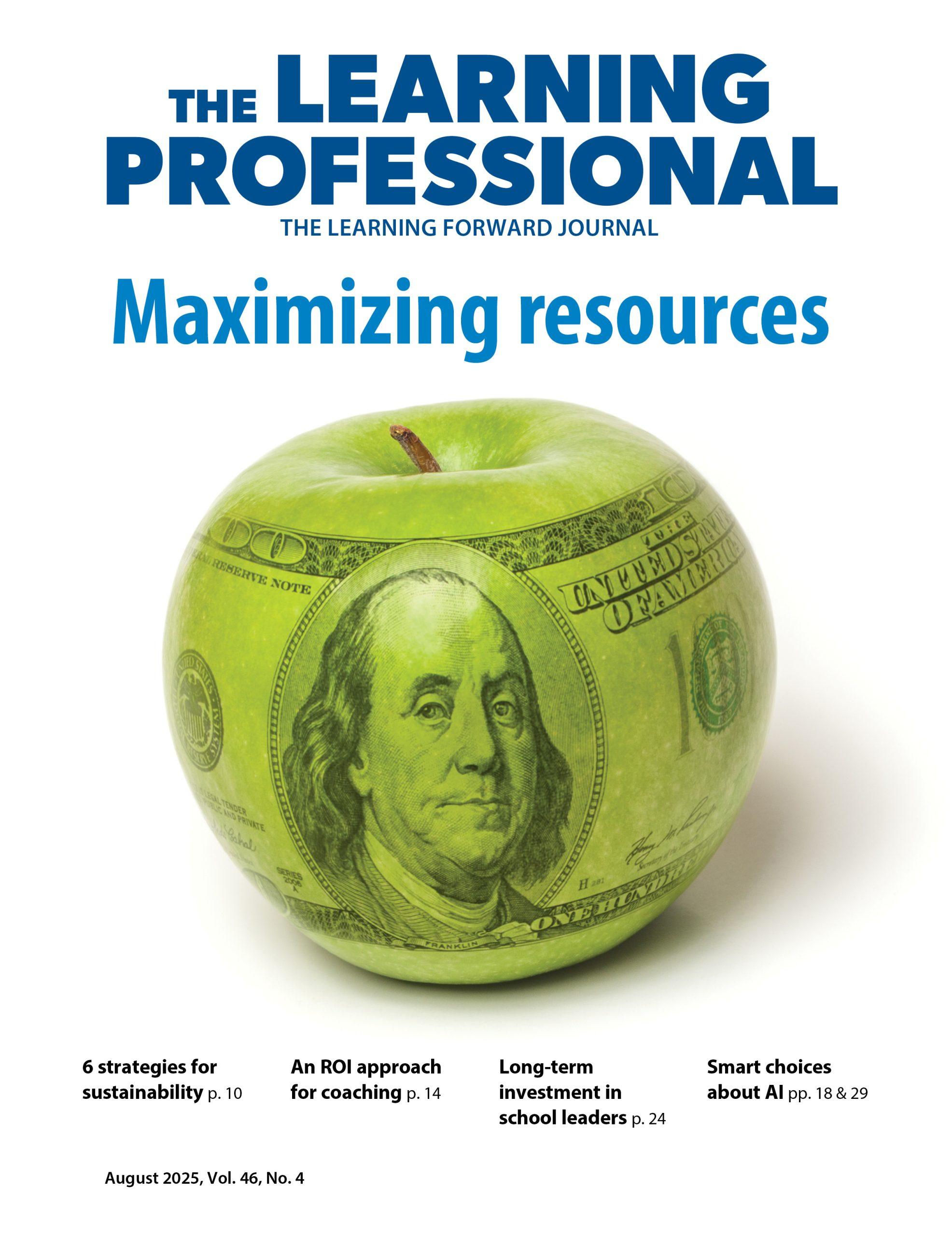Clear Goals, Clear Results
Content-focused routines support learning for everyone - including teachers
By Learning Forward
Categories: Coaching, Collaboration, ImplementationFebruary 2015
Read the remaining content with membership access. Join or log in below to continue.
Sed ut perspiciatis unde omnis iste natus error sit voluptatem accusantium doloremque laudantium, totam rem aperiam, eaque ipsa quae ab illo inventore veritatis et quasi architecto beatae vitae dicta sunt explicabo. Nemo enim ipsam voluptatem quia voluptas sit aspernatur aut odit aut fugit, sed quia consequuntur magni dolores eos qui ratione voluptatem sequi nesciunt. Neque porro quisquam est, qui dolorem ipsum quia dolor sit amet, consectetur, adipisci velit, sed quia non numquam eius modi tempora incidunt ut labore et dolore magnam aliquam quaerat voluptatem.
Guidelines for Designing Text Discussions of Literary and Informational Texts
| Based on the Questioning the Author approach | |
| Components | Approach |
| Texts | Select texts that contain a sufficient range of complexities to provide grist for students to build meaning. |
| Major understandings | Decide on the major ideas to be developed by students about the text. Where? How? By whom? |
| Challenges to comprehension | Determine where inferences are needed, where abstract language is used, where transitions are omitted or ineffective, how the text structure may pose difficulty. |
| Text segments | Decide where to stop to initiate discussion. |
| Initial queries | Intersperse open-ended questions during the first reading (rather than saving them until the end). Use questions that require students to describe and explain text ideas, rather than recall and retrieve words from text. |
| Desired student responses | Determine in advance the desired student responses that signal comprehension, and use them as the road map for the conversation. |
| Follow-up questions | Use questions that encourage student elaboration and development of ideas; listen carefully to student responses and take these into account when formulating follow-up questions; scaffold students’ thinking. |
| Illustrations | In general, if there are illustrations, present them after students have heard and responded to the related section of text. |
| Background knowledge | Use invitations for background knowledge judiciously to support meaning building but not to encourage students to tap into tangential experiences. |
| Vocabulary | Select some sophisticated words for direct attention after reading and discussion of the story are completed. |
Learning Lab: Reflection Rounds
| Teachers take descriptive notes as they observe a fellow (host) teacher teaching students. Participants provide substantive feedback about something they saw or heard the host teacher do that aligns with the practice under study and its impact on student learning. |
| REFLECTION ONE: EVIDENCE OF STUDENT LEARNING |
| Learners |
| Use observation notes to address questions such as:What specific responses did students make that are:
Evidence of their understanding of the intended learning? Evidence of misunderstandings or confusions? Evidence of the impact of certain instructional moves? What might be the next learning for these students? |
| Host teacher: |
| Reflect on evidence of student learning using experience teaching the lesson, knowledge of student strengths and needs, progress over time, classroom dynamics, etc.Respond or not to any of the questions posed for reflection or clarification. |
| REFLECTION TWO: EVIDENCE OF TEACHER LEARNING AROUND FOCUS QUESTION |
| Learners: |
| Use observation notes to address questions such as:What did you see or hear the teacher or students say or do relative to the teacher’s focus question?
What questions do you have that might prompt reflection? |
| Host teacher: |
| Use experience teaching this lesson to clarify or provide additional context based on the learners’ reflections.Respond or not to any of the questions posed for reflection or clarification. |
| REFLECTION THREE: COMMITMENT AND ACTION STEPS |
| Learners and host teacher reflect: |
| What was new learning for me about our learning focus question?How did this observation deepen my understanding?
How did this observation challenge my thinking? What are the implications of this observation for my practice? What additional professional learning do I need to support or sustain the instructional practices observed in my school? What should our next learning be to build on this experience? |
| REFLECTION FOUR: LESSON OBSERVATION PROCESS |
| Learners and host teacher reflect: |
| Was this lesson observation a useful professional learning opportunity? Why or why not?In what ways was the reflection process meaningful? How could the process be improved?
How and when will we revisit our learning from this observation? |
Evidence-Based Reasoning Tool
| This tool lends structure to participants’ comments.Participants:
Name what they saw or heard; Identify how it aligns with/illustrates something they’ve been studying; Say what this seems to indicate in terms of teacher or student learning; and Raise questions/comments about what they saw or heard. |
|||
| 1 Observations | 2 Analysis | 3 Interpretation of cause and effect | 4 Questions or suggestions |
| I saw or I heard:The teacher provided a lot of information to students about the text they were about to read.
Bella said, “I’m not sure that’s right. Can we look at that again?” |
This seems to be evidence of:The teacher is trying to build background knowledge.
Students’ commitment to accuracy. |
This leads me to think that:The teacher is trying to support student learning by scaffolding their reading.
Students have internalized the norms for classroom discussion. |
I wonder:Was this necessary or could they have determined some of this information for themselves while reading?
What did this teacher do to support students to take on this role for themselves? |
References
Beck, I.L. & McKeown, M.B. (2006). Improving comprehension with Questioning the Author: A fresh and expanded view of a powerful approach. New York, NY: Scholastic.
Matsumura, L.C., Garnier H.E., & Spybrook, J. (2013). Literacy coaching to improve student reading achievement: A multi-level mediation model. Learning and Instruction, 25, 35-48.
Matsumura, L.C., Sartoris, M., Bickel, D.D., & Garnier, H.E. (2009). Leadership for literacy coaching: The principal’s role in launching a new coaching program. Educational Administration Quarterly, 45(5), 655-693.
McCarthy, K.A., Bickel, D.D., & Artz, N. (2010). Using a practice-based hiring process supports coaches to support teachers. Pittsburgh, PA: University of Pittsburgh, Learning Research and Development Center. Available at https://ifl.pitt.edu/index.php/educator_resources/publications.
Pearson, P.D. & Gallagher, M.C. (1983). The instruction of reading comprehension. Contemporary Educational Psychology, 8(3), 317-344.
Learning Forward is the only professional association devoted exclusively to those who work in educator professional development. We help our members plan, implement, and measure high-quality professional learning so they can achieve success with their systems, schools, and students.
Categories: Coaching, Collaboration, Implementation
Recent Issues
MAXIMIZING RESOURCES
August 2025
This issue offers advice about making the most of professional learning...
MEASURING LEARNING
June 2025
To know if your professional learning is successful, measure educators’...
NAVIGATING NEW ROLES
April 2025
Whether you’re new to your role or supporting others who are new,...
LEARNING DESIGNS
February 2025
How we learn influences what we learn. This issue shares essential...









